Hyperopia (Farsightedness) Treatment for Children & Adults
We help children and adults see clearly by diagnosing and treating vision problems like Myopia, Hyperopia, Astigmatism, and Lazy Eye.
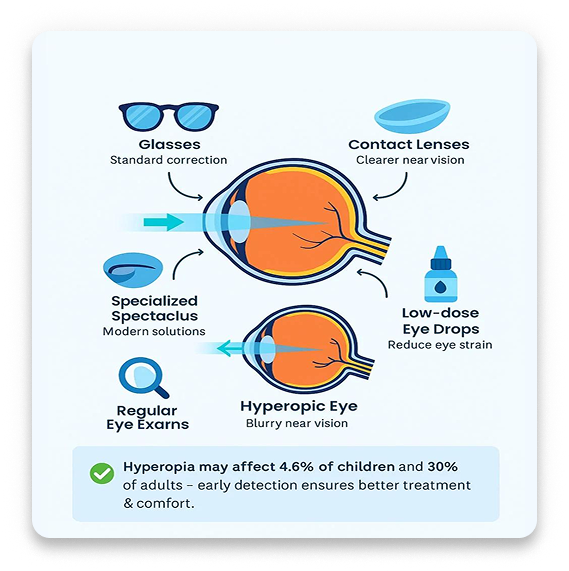
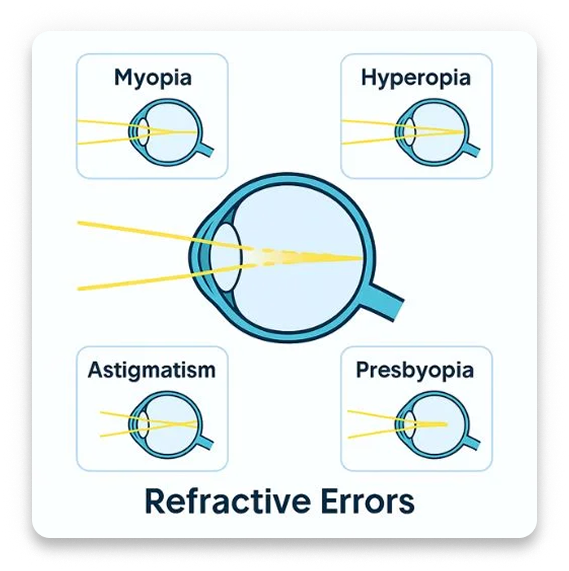
What is Hyperopia?
Hyperopia (farsightedness) is a common eye condition that may cause you to have blurry close-up vision. People with hyperopia typically have an easier time seeing Objects that are far away (at
least 6 meters, or almost 20 feet), but have difficulty focusing their eyes on things that are close up.
The shape of your eye determines whether you have some degree Of hyperopia. Factors include the length Of your eye from front to back (axial length) and the curvature of your cornea (the front “window” of your eye), Your eye shape affects how your eye receives and processes light to allow you to see.
You can’t control the shape of your eye, and hyperopia isn’t an eye disease, Healthcare providers consider it an eye focusing disorder because it affects how your eye focuses light. Hyperopia is common and correctable.
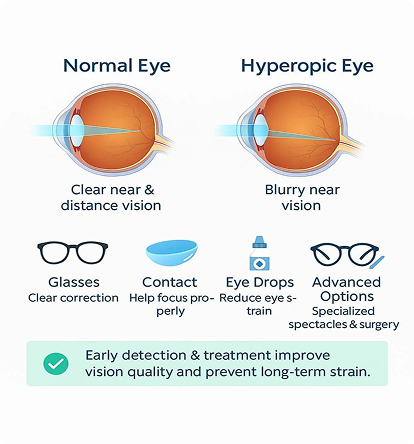

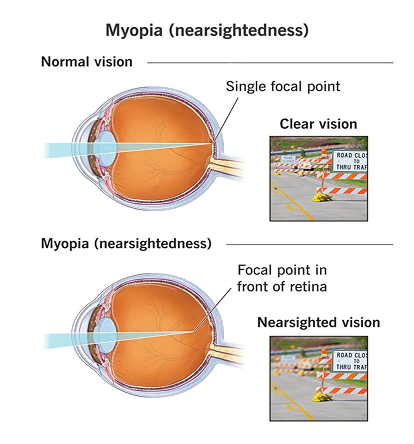

What Causes Hyperopia?
Your cornea is the clear, outer layer of your eye. This “window” bends light as it enters your eye and helps it land on your retina, a thin layer of tissue at the back of your eye. Your cornea is slightly
curved. That curvature bends light entering your eye at just the right angle so it reaches your retina.
But if your cornea is too flat, or if the distance between the front and back of your eye is too short, this delicate balance is thrown off. As a result, light enters your eye but doesn’t hit its target (your
retina). Instead, light rays are under-focused, meaning they land behind your retina.
This causes objects up close to look blurry. Sometimes, other parts of your eye can accommodate to help you see clearly. But with higher degrees of farsightedness, your eyes might need help from
glasses or other methods to focus.
How is Hyperopia Diagnosed?
You can get tested for hyperopia through a comprehensive (but painless) eye exam. During an exam, an optometrist or ophthalmologist will use eye drops to dilate your eyes. The drops increase the size of your pupils to let in more light.
Your provider will shine lights into your eye and use various instruments to check
your eye health. They’ll look for refractive errors (like hyperopia) but also a wide range of conditions (like glaucoma and cataracts).
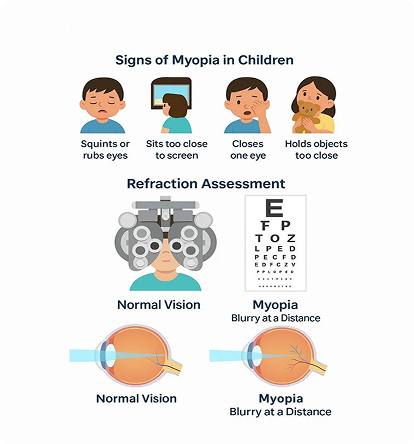

Hyperopia Symptoms
Eyeglasses, contact lenses and surgery can correct your vision and ease your discomfort. An eye care provider will help you decide what's best for your needs.
Eye Drops
Especially when looking at things that are close to your face
Eye Strain
Eye muscles working harder to help you see clealy
Headaches
Dull Pain in you eye from focusing effort
Reading Difficulty
Trouble focusing on close-up text and materials
Double Vision
Seeing double when reading or doing close work
Night Fatigue
Blurred vision and fatigue at night
Potential Complications
Daily Impact
- Hyperopia can cause uncomfortable symptoms (like headaches) that make it harder for you to do your daily tasks.
Children's Risk
- Children with high degrees of hyperopia may develop amblyopia (lazy eye) or strabismus (eyes that look in different directions). Eye exams during childhood can identify refractive errors like hyperopia before they lead to complications.
Comprehensive Hyperopia Treatment Options
Eyeglasses, contact lenses and surgery can correct your vision and ease your discomfort. An eye care provider will help you decide what's best for your needs.
Eyeglasses
- The lenses in eyeglasses provide a simple way to correct hyperopia. They do so by changing the way light focuses on your retina. Your degree of hyperopia determines what type of lenses you need and how often you should wear them.
Contact Lenses
- Contact lenses work like eyeglasses. They correct the way light bends when it enters your eye. But contacts are smaller than the lenses in your glasses, and they sit directly on the surface of your eyeball. They're generally safe, comfortable and convenient. However, you may run into issues that prevent you from wearing contacts, such as dry eye and eye infections.
Surgery
- You may choose to have surgery to correct hyperopia. There are many different options based on your degree of hyperopia. LASIK eye surgery helps people with lower degrees of hyperopia. It uses a laser to reshape your cornea. For people with higher degrees of hyperopia, refractive lens exchange may help.
Benefits of Treatment
With proper treatment, hyperopia can be effectively managed to restore clear vision and reduce symptoms like headaches and eye strain.
- Clear close-up and distance vision
- Reduced eye strain and fatigue
- Relief from headaches and eye pain
- Improved reading and close-up tasks


Long-term Outlook & Management
Hyperopia (farsightedness) doesn't go away unless you have surgery. But even after surgery, your vision can change over time due to natural aging processes.
Ongoing Management
- Glasses or contacts can correct your vision and help your eyes focus. But when you’re not wearing them, you may have symptoms of hyperopia. Plus, your vision can still change and get blurrier over time. You may notice that your glasses don’t help as much as they used to.
Regular Eye Exams
- It’s important to wear your glasses or contacts as often as your provider recommends. You should also have regular eye exams in case you need to change the strength of your lenses.
Prevention & Eye Health
There's no proven way to prevent hyperopia. However, some lifestyle habits can help keep your eyes healthy.
Nutritious Diet
Nutrients like vitamin A, vitamin C, vitamin E and lutein help protect your vision. Add lots of fruit (like grapefruit and strawberries) and veggies (like leafy greens) to your plate.
Regular Eye Exams
Your provider can check for eye problems before you have symptoms.
UV Protection
Wear sunglasses, even on cloudy days. Choose sunglasses that block 99% or more of the sun's ultraviolet (UV) radiation.
Rest Your Eyes
Looking at a screen for hours can tire your eyes and lead to computer vision syndrome. Making some small changes to your routine can help prevent or ease discomfort.
